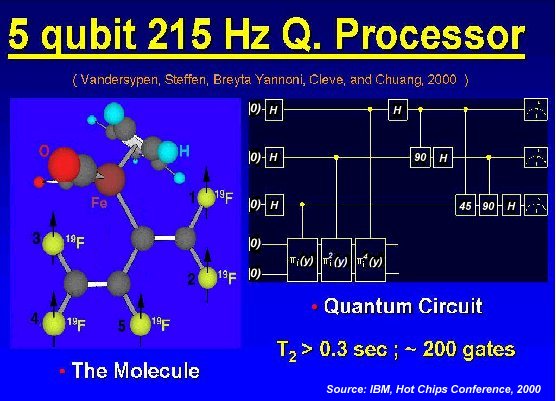Qubits and The Number 42: 12th Annual Hot Chips Conference in Palo Alto
Introduction
The Hot Chips Conference that takes place at Stanford University in Palo Alto every summer typically focuses on new chip architectures and innovative techniques. Of course it is also about performance, clock rates, power integration and usefulness. This year the conference embraced the new 'darling' of the chip industry - the network processor. The two sessions included presentations from SwitchOn, SiliconAccess, EmpowerTel, Vitesse, C-Port, and IBM.
But IBM had some interesting research to talk about as well, like for example their quantum computer that is being developed in the companies' Almaden Research Center in San Jose, CA. Scientist Isaac Chung presented a paper on a 215 Hz, 5-qubit quantum processor. It is currently the largest quantum computer in the world - a 5 bit computer in a single molecule. The molecule consists of five fluorine atoms, each representing a quantum bit, or 'qubit'.
Chuang and his team of researchers have been working on quantum computers (QCs) since the late 1980s. His most recent success, the 5-qubit QC, is able to solve the order-finding problem, a problem related to code cracking, in a single step. The order-finding problem determines the period of a function. Digital computers must calculate the solution by using step-by-step iterations of the function's values until they begin to repeat. The qubits take this problem to a whole new level. By nature they represent all possible values of the input variables simultaneously, hence the QC is able to consider every possible input value at once and only needs one step to solve the problem. This is the ultimate in parallel computing: parallel processing at bit level.
IBM's quantum computer uses a molecule with five fluorine atoms, each representing 1 qubit.
According to Chuang quantum computers may someday be able to live up to their potential of solving, in remarkable short times, problems that are so complex that the most powerful supercomputers couldn't calculate the answers even if they worked on them for millions of years.
That really made me smile because it reminded me of Douglas Adams' sci-fi novel 'The Hitchhiker's Guide to the Galaxy', which was extremely popular in my college years back in the 1980s. In one of the books a supercomputer was asked to come up with an answer to 'the meaning of life, the universe and everything'. It took millions of years and the answer was - 42. I guess a quantum computer would have been most helpful in speeding things up a bit.
Okay - back to the serious side of science now. IBM's latest achievement is a great success and step forward in the area of quantum computing, but it still has a long way to go before it can actually compete with digital supercomputers. For example quantum systems typically have a short lifetime, and the external control of quantum mechanics is quite difficult. Nevertheless, researchers are confident that QCs will meet this challenge within this decade. If the difficulties in connection with molecular methods can be overcome, the latter might represent an advance over silicon-circuit fabrication processes. Quantum circuits could be manufactured by using automatic controlled chemical reactions making the present definition of complex circuits obsolete. But until then processor designers and manufacturers must stick to the old-fashioned way of building chips.
Get Tom's Hardware's best news and in-depth reviews, straight to your inbox.
